Standards Worldwide
Standards Worldwide
Phone +49 30 58885700-07

Standard [CURRENT]
ASTM D 5197:2021
Standard Test Method for Determination of Formaldehyde and Other Carbonyl Compounds in Air (Active Sampler Methodology)
- German title
- Prüfverfahren für die Bestimmung des Formaldehyds und anderer Carbonylverbindungen in der Luft (Methodik des aktiven Probenahmegeräts)
- Publication date
- 2021
- Original language
- English
- Pages
- 16
- Publication date
- 2021
- Original language
- English
- Pages
- 16
- DOI
- https://dx.doi.org/10.1520/D5197-21
Product information on this site:
Quick delivery via download or delivery service
Buy securely with a credit card or pay upon receipt of invoice
All transactions are encrypted
Short description
1.1 This test method presents a procedure for the determination of formaldehyde (HCHO) and other carbonyl compounds (aldehydes and ketones) in air. Other carbonyl compounds that have been successfully quantified by this method include acetaldehyde, acetone, propanal (propionaldehyde), 2-butanone (methyl ethyl ketone), butyraldehyde, benzaldehyde, isovaleraldehyde, valeraldehyde, o-tolualdehyde, m-tolualdehyde, p-tolualdehyde, hexanal, and 2,5-dimethylbenzaldehyde. 1.2 This test method involves drawing air through a cartridge containing silica gel coated with 2,4-dinitrophenylhydrazine (DNPH) reagent. Carbonyl compounds readily form stable derivatives with the acidified DNPH reagent. The DNPH derivatives are analyzed for parent aldehydes and ketones using high performance liquid chromatography (HPLC) or ultra-high performance liquid chromatography (UHPLC). UHPLC systems use higher pressures and smaller particle sizes in columns compared to HPLC systems. The sampling procedure is a modification of U.S. EPA Method TO-11A (see 2.2 ). 1.3 This test method is based on the reaction of carbonyl compounds with DNPH in the presence of an acid to form stable derivatives according to the reaction shown in Fig. 1 , (where: both R and R 1 are alkyl or aromatic groups (ketones), or either, or both R or R 1 is a hydrogen atom (aldehydes)). The determination of formaldehyde and other carbonyl compounds, as DNPH derivatives, is similar to that of U.S. EPA Method TO-11A in that it uses HPLC or UHPLC for separation of carbonyl compounds followed by UV adsorption or photodiode array detection. This test method exceeds the stated applicability of TO-11A to include other carbonyl compounds that can be determined as stated in 10.2.4 . This test method is suitable for determination of formaldehyde and other carbonyl compounds in the airborne concentration range from approximately 10 ppb v/v (12 μg/m3), requires sampling for 1 h at 1 L/min) to 1 ppm v/v (1.2 mg/m3). Lower concentrations in air may be determined using higher sampling volume and with control of contamination, appropriate selection of flow rate and sampling duration. FIG. 1 Reaction of Carbonyl Compounds 1.4 The sampling method gives a time-weighted average (TWA) sample. It can be used for long-term (1 to 24 h) or short-term (5 to 60 min) sampling of air for formaldehyde. Shorter sampling times or low flow rates will result in higher detection limits and may result in greater variation in co-located sampler results. Tests should be performed over a duration and a flow rate that allows the data quality objective of the project to be achieved. Sample times for other carbonyls, such as acetaldehyde, may be limited to short term ( 1 ) . 2 The data provides total concentrations of carbonyl compounds from which time weighted average concentrations can be calculated. 1.5 This test method instructs the user on how to prepare sampling cartridges from commercially available chromatographic grade silica gel cartridges 3 by the application of acidified DNPH to each cartridge. 1.6 The sampling flow rate, as described in this test method, has been validated for sampling rates up to 1.5 L/min for formaldehyde. This flow rate limitation is principally due to the high pressure drop (>8 kPa at 1.0 L/min) across user prepared silica gel cartridges which have a particle size of 55 to 105 µm. These cartridges are not generally compatible with battery-powered pumps used in personal sampling equipment (for example, those used by industrial hygienists). 1.7 Alternatively, pre-coated DNPH silica gel cartridges are commercially available and may be substituted provided they can be demonstrated to meet blank and analyte trapping acceptance criteria ( 2 ) . Some of these use silica gel of a larger particle size that results in a lower pressure drop across the cartridge. These low pressure drop cartridges may be more suitable for sampling air using battery-powered personal sampling pumps. 1.8 The values stated in SI units are to be regarded as standard. No other units of measurement are included in this standard. 1.9 This standard does not purport to address all of the safety concerns, if any, associated with its use. It is the responsibility of the user of this standard to establish appropriate safety, health, and environmental practices and determine the applicability of regulatory limitations prior to use. 1.10 This international standard was developed in accordance with internationally recognized principles on standardization established in the Decision on Principles for the Development of International Standards, Guides and Recommendations issued by the World Trade Organization Technical Barriers to Trade (TBT) Committee.
ICS
71.080.80
DOI
https://dx.doi.org/10.1520/D5197-21
Also available in
Loading recommended items...
Loading recommended items...
Loading recommended items...
